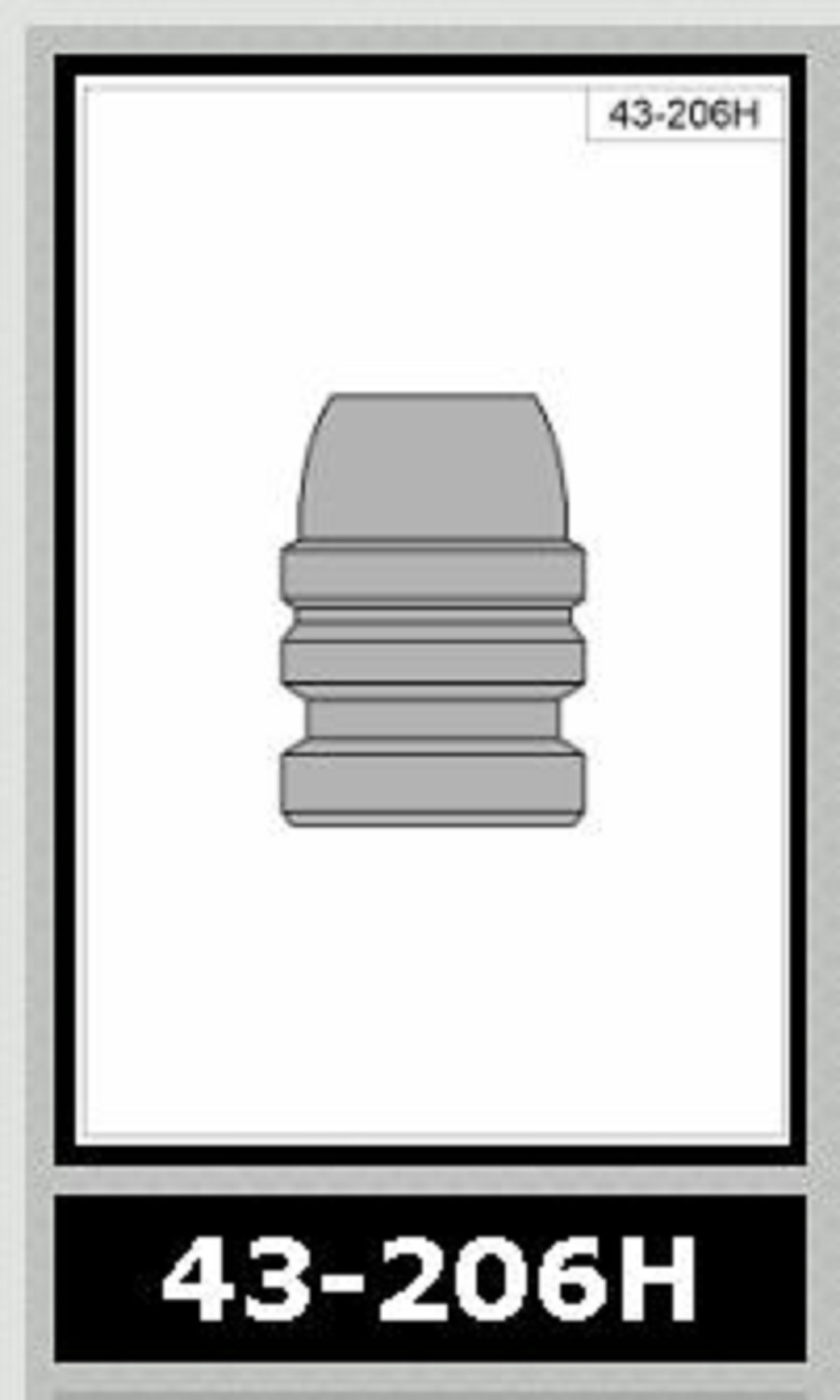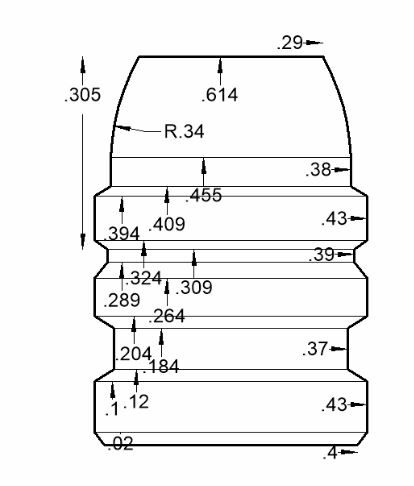You are using an out of date browser. It may not display this or other websites correctly.
You should upgrade or use an alternative browser.
You should upgrade or use an alternative browser.
Heads Up On A New Design At Accurate Molds--#43-206H
- Thread starter CZ93X62
- Start date
F
freebullet
Guest
I noticed & found odd he doesn't have any round nose designs a while back, guess that explains it.
Last edited by a moderator:
KeithB
Resident Half Fast Machinist
He is probably using a CNC milling machine and using a smaller diameter cutter than the cavity and commanding the machine to move the table in a circular motion. This is called circular interpolation. The table doesn't actually rotate, but the X and Y axes table screws are controlled in direction and speed to move the table so that it moves in a circle under the cutter. Most machines have a minimum diameter they can interpolate, add that to the minimum cutter diameter and that is the minimum diameter cavity you can cut.
fiver
Well-Known Member
they fall out of the mold easier.
it's a trait magma molds had forever and 3 days, it took an act of god [change of management] to get that changed.
for a 44-40 with the somewhat thinner case walls a slight bevel to the base of the bullet actually makes sense.
I have discussed the caliber with Outpost several times and shared some of the tricks we both use in the past to make sure we don't crunch up a bunch of cases [as few as possible anyway]
this would make a pretty good 44 special bullet BTW.
it's a trait magma molds had forever and 3 days, it took an act of god [change of management] to get that changed.
for a 44-40 with the somewhat thinner case walls a slight bevel to the base of the bullet actually makes sense.
I have discussed the caliber with Outpost several times and shared some of the tricks we both use in the past to make sure we don't crunch up a bunch of cases [as few as possible anyway]
this would make a pretty good 44 special bullet BTW.
Ian
Notorious member
Tom uses a CNC lathe to bore his moulds. He starts out by plunging in a .180" hole and uses tiny boring bars to go out from there. This is why he limits lube groove depth, lube groove/crimp groove draft angle, and doesn't do nose-pour or round ball designs. He also doesn't do smaller than .30-caliber although if the groove depth is minimal he can go down to 7mm or so.
I tried to talk him into at least boring through the blocks at .180" so I could make a pointy or HP spud of my own but he tried it and I guess ruined a block set because he got back with me and said he wasn't ever going to try that again. I also tried to convince him to at least poke an end-cutting ball mill in there and round the nose for my autoloaders but no dice. Good news is I can do that myself with an epoxy guide bushing.
I tried to talk him into at least boring through the blocks at .180" so I could make a pointy or HP spud of my own but he tried it and I guess ruined a block set because he got back with me and said he wasn't ever going to try that again. I also tried to convince him to at least poke an end-cutting ball mill in there and round the nose for my autoloaders but no dice. Good news is I can do that myself with an epoxy guide bushing.
CZ93X62
Official forum enigma
Mountain Molds has similar design limits to those of Accurate Molds (.270" or 6.5mm). I figured it related to fixture or machining limitations, and left it at that. Their house, their rules.
Starline brass in 44/40 WCF is a lot less prone to caving in than is W-W or R-P.
When Outpost 75 says or does something, I pay attention. That man knows his business. I am not enamored of bevel bases, but if "75" prefers them I suspect he has a good reason. You could always ask the mouldmaker if the BB could be deleted, I would imagine.
Starline brass in 44/40 WCF is a lot less prone to caving in than is W-W or R-P.
When Outpost 75 says or does something, I pay attention. That man knows his business. I am not enamored of bevel bases, but if "75" prefers them I suspect he has a good reason. You could always ask the mouldmaker if the BB could be deleted, I would imagine.
Last edited:
RicinYakima
High Steppes of Eastern Washington
I'm waiting for some for the .44 Russian with black powder.
Outpost75
Active Member
.... I am not enamored of bevel bases, but if "75" prefers them I suspect he has a good reason. You could always ask the mouldmaker if the BB could be deleted, I would imagine.
Tom can cut any of his listed bevel-base designs with a conventional square base. You only need to tell him when you order whether you want to remove the bevel and shorten/lighten the bullet slightly, or maintain the same overall length and bump the weight up very slightly. He can do either.
Outpost75
Active Member
My reasoning for a bevel base is that when a bullet which fits revolver cylinder throats which are larger in diameter than the barrel groove diameter, a bevel base is less likely to drag a "fin" off the base of the bullet, as it is extruded into the smaller diameter barrel.
A bevel base does not present a tiny, sharp corner, having a lower heat capacity, which is more likely to result in "cupping" or ablative deposit of leading to the bore in heavy loads.
A bevel base starts more easily into the case mouth and is less prone to buckle the case or damage the bullet heel in seating.
The usual complaint most people have of bevel based bullets, picking up a ring of bullet lubricant which may attack powder, and therefore requiring laborious wiping of the bullet base, I have found to be a non-issue if you use a concave base punch in your bullet sizing and lubricating die, which "fits" the bullet base and creates a positive seal around the bullet. It is also a non-issue if you use the Star bullet sizer, or if you use any of the tumble-on film lubes like Lee Liquid Alox or LSStuff 45-45-10 and a push-through sizer.
Some people claim that a bevel-based bullet is "disturbed" upon muzzle exit and that a flat, square base is more accurate. I have recovered many fired bullets of my designs from Accurate molds, shot with full charges and 1:30 tin-lead alloy from Roto Metals, and NO bevel remained on the fired bullet, it having been obliterated by base upset upon firing. However, MORE important is that there was no cupping or finning of the base in full revolver charges over 900 fps, which I have frequently observed in soft flat-based bullets.
Accuracy of my bevel-based designs, when cast of 1:30 alloy in molds which drop correct diameter which "fits" is excellent. A charge of 6 grains of Bullseye approximates factory load velocity in the .44-40 with 43-206H and is accurate in my vintage Colts, as shown below.
Not bad for a 71-year-old curmudgeon at 25 yards using fixed sight off sandbags.


A bevel base does not present a tiny, sharp corner, having a lower heat capacity, which is more likely to result in "cupping" or ablative deposit of leading to the bore in heavy loads.
A bevel base starts more easily into the case mouth and is less prone to buckle the case or damage the bullet heel in seating.
The usual complaint most people have of bevel based bullets, picking up a ring of bullet lubricant which may attack powder, and therefore requiring laborious wiping of the bullet base, I have found to be a non-issue if you use a concave base punch in your bullet sizing and lubricating die, which "fits" the bullet base and creates a positive seal around the bullet. It is also a non-issue if you use the Star bullet sizer, or if you use any of the tumble-on film lubes like Lee Liquid Alox or LSStuff 45-45-10 and a push-through sizer.
Some people claim that a bevel-based bullet is "disturbed" upon muzzle exit and that a flat, square base is more accurate. I have recovered many fired bullets of my designs from Accurate molds, shot with full charges and 1:30 tin-lead alloy from Roto Metals, and NO bevel remained on the fired bullet, it having been obliterated by base upset upon firing. However, MORE important is that there was no cupping or finning of the base in full revolver charges over 900 fps, which I have frequently observed in soft flat-based bullets.
Accuracy of my bevel-based designs, when cast of 1:30 alloy in molds which drop correct diameter which "fits" is excellent. A charge of 6 grains of Bullseye approximates factory load velocity in the .44-40 with 43-206H and is accurate in my vintage Colts, as shown below.
Not bad for a 71-year-old curmudgeon at 25 yards using fixed sight off sandbags.


Last edited:


